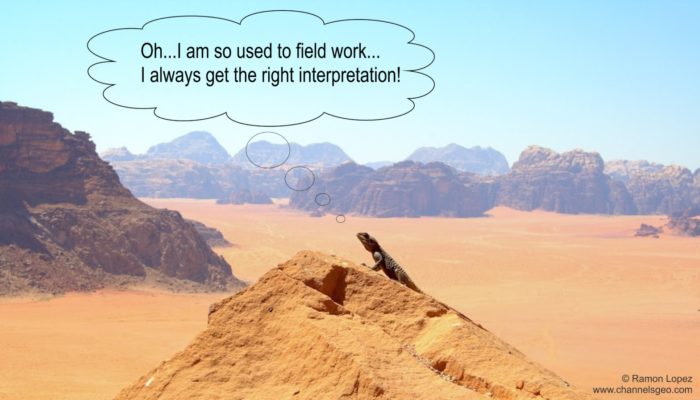
There are not many scientific publications that tackle the issue of subjectivity in geological studies and its impact. In one of them, Baddeley et al. (2004), they state it clearly in some sentences: “the judgements of experts can be biased by their use of heuristics to guide the formation of their opinions” or “accepted or prior opinions of existing experts certainly affect the judgement of others, including future experts in the making”. Let’s talk a bit about this matter, as sedimentologists, from the very moment we observe an outcrop.
A sedimentologist gets to the outcrop, looks at it from some distance and then gets closer to get a look from just a few centimetres away. Draws sketches and sedimentary logs and takes notes. All objective data…or not? Ok, let’s assume that all of that collected information was objective and complete. After the data collection the sedimentologist decides that it is time to just think about the palaeoenvironment – some preliminary ideas had already come up to her/his mind inevitably –
How would the environment look like when all those sedimentary rocks were just loose particles? – subaerial? underwater? marine? fluvial? What process would move them around? Wind, water? This is just the start. All the information from the outcrop was recorded in certain format, but it can be reformatted to a different one when in the ‘office’. The ‘raw data’ might also be processed through mathematical tools. At this point, the most common situation is a sedimentologist looking for ‘evidence’ to a hypothesis she/he has in mind. The sedimentologist is in the stage of interpretation. The key word is: evidence. But, what is really evidence and how we determine it? The evidence is constructed from the sum of the following: (1) observations, (2) data recording, (3) data processing and (4) data interpretation.
(1) Observations: they are just descriptions we make from all those external signals our human body receives and processes. The fact that different people may not observe the same features than others can be explained by differences in the cellular systems that perform the reception and process of external signals in each of us (e.g., light that is received by cells in our eyes, transformed into a different type of signal and then processed by neurons). The most common difference among us is on the sharpness and colour of our vision. Just the variability in this matter can result in rather different observations. But we do not need to compare to each other in the search of variability of observations to the same outcrop. During my years as field geologist I have corrected my own observations so many times in some outcrops when I would get closer to the outcrop or just when I would change the angle of view. Experience has made me more and more cautious when recording those observations as immutable ones.
(2) Data recording: here we jump straightaway into the field of heuristics. Heuristics are the strategies we follow to solve a problem that are derived from previous experiences tackling similar problems. We are in front of an outcrop because we want to better understand nature; most likely a given aspect of it, for example, the processes and consequences of sediment transport in fluvial systems. What information are we going to record and what we will ‘discard’? Yes, discard, because we cannot record all the information that an outcrop possesses and because we have been taught by somebody else that we have to care about certain information and not to care on other. We are also taught how to structure and organise our field data. Some sedimentologists decide to record data in a form or from observations that are different from what is usual. How can we be sure we are recording the relevant data, and in the appropriate form, that we need to advance in our field of science? You are confident you do it? I am not.
(3) Data processing: here heuristics are again fundamental. The sedimentologist could use some statistical tools or models to see if there are any patterns on the data set. Those patters could be radically different depending on the statistical tool or model used. Prediction is a long-desired capability for most sedimentologists, and patterns help to define predictive rules. Again, I have found myself and others readily talking about cycles and hierarchical organization when discussing on field data. Pretty much never about randomness. When we use statistics, we are eager to find patterns. Let’s admit it, we love to think that nature pretty much always shows us an organised sedimentary record. Can this mind set be a problem for sedimentological studies? I think so.
(4) Data interpretation: this is the final stage and perhaps the one where a sedimentologist will be more prone to suffer issues with heuristics. This is because we feel the ‘pressure’ to reaching a conclusion, and if just one and unequivocal, far better. There are a good range of biases that result from the heuristics we use; and these biases takes all of us to make mistakes. Table 1 summarises some examples of heuristic biases with possible occurrences for outcrop studies.
Next time you get to an outcrop, no matter how much of an expert you think you are, remember you will fall for some of them.
References
Baddeley, M.C., Curtis, A. and Wood, R., 2004. An introduction to prior information derived from probabilistic judgements: elicitation of knowledge, cognitive bias and herding. Geological Society, London, Special Publications, 239(1), pp.15-27.





